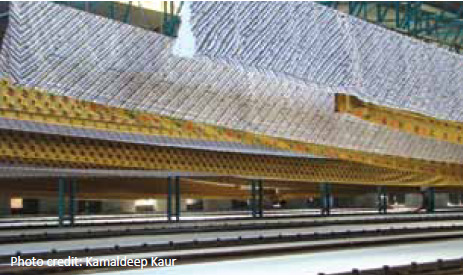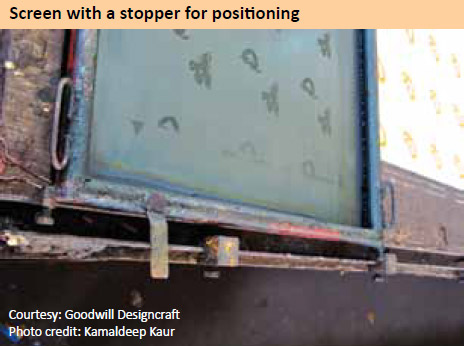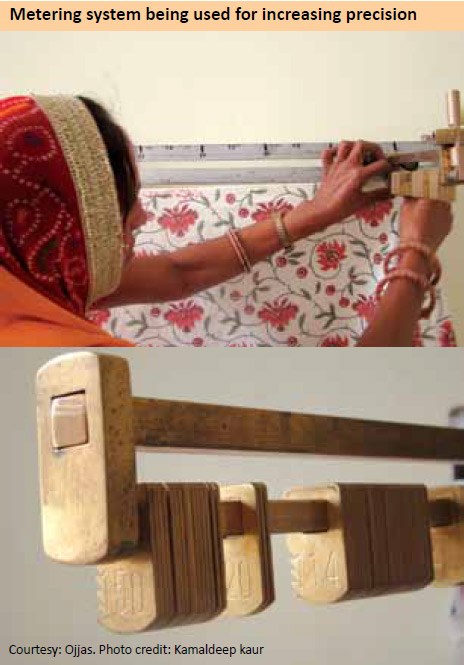Specifications of a typical unit making 1000 metres per day
A unit that prints 1000 metres per day requires at least 6 tables of 12-13 metres in length and must have the capacity to print 200 meters per day from each table. This will depend totally on the design and number of colours. A typical view of such a unit is given below;

Screen printing units are usually much bigger than the block printing units. The screen tables are much more longer than the block tables, which itself makes it necessary to have a larger space.
Lighting lamps are always found in printing units hanging above the tables, so that the printer can see the tools involved very clearly. The roof tops are very high (over 15 feet) for ventilation, as it is not possible to have fans, as fans will dry the paste and the colours. The temperature varies according to the season, but needs to be maintained inside according to the technique being practised. Thus colour pastes often need to be made with different consistencies in each season to facilitate printing.
Table design
Mostly, wooden tables with an inclination are used for printing with screens and wax. An adhesive is applied on the top. In some areas like Jaipur and Gujarat, Tables with stone top are also used and over stone a coating of wax/ adhesive is applied. Heat for drying the printed fabric may be provided either under the blanket or by hot air fans above the table.
Fabric movement or shrinkage must be avoided during printing in order to maintain registration of the pattern. The fabric to be printed is laid on to the table and stuck to the blanket directly, using either a water-soluble adhesive or a semi-permanent adhesive; alternatively it is ‘combined’ with a back-grey. In the latter instance an absorbent fabric is stuck to the blanket and the fabric to be printed is pinned down on top of it. Sometimes fabric and back-grey are combined before fixing to the table using an adhesive and a specially adapted pad mangle. Combining is most suitable for printing light weight fabrics, where there is a danger of smudging or loss of adhesion caused by the presence of excessive print paste.
Equipment –Table’s trays trolleys etc
On each table one colour tray is required to pour the paste onto the screen so 5-6 buckets are required for the paste per table. Number of squeezes depends upon the numbers colours to be printed in the given design. After printing a sun dry facility is required which may consist of GI pipes stand.

Colour kitchen – chemical storage, basic equipment needed
A well vented area for the storage of dyes, pigments and chemicals is required. Chemicals must be stored as per guidelines laid down in the MSDS of each chemical. Weighing instruments must be procured for various measurements. These must be calibrated regularly to avoid any misreading. A good quality of stirrer must be present in the unit to make print paste with variable speed. Unit must have viscosity cup to check viscosity of the print paste and maintaining desired quality level of prints.
Washing area
Once the printing process is over, fabric needs to be washed to remove extra ingredients and unfixed colours. Normally washing tanks are necessary for this purpose which have water inlet and drain facility. If possible an arrangement can be made for the re-use of the used water in subsequent washings.
Drying in open air, by curing machines or by ironing
After printing of fabric various post processes are necessary to fix the prints. These include a curing chamber; hot iron presses and sheds for drying in the sun. For reactive dyes silicate padding is required. Sun drying shed consists of G.I. pipes or wooden sticks at equal distance over a stand, at a location where there is direct exposure from the sun.
Packing and finishing
After printing and post processing is over, the fabric needs to be checked for quality. One requires sufficient number of tables with an appropriate over-head lighting system. Folding is done with the help of manual “Folding Kaanta” in the same area. Finishing of the fabric is done to remove stains, loose threads and miss- prints. The finished fabric is thus packed according to the instructions of the buyers, or depending upon its final destination.

Storage and practices
Finished fabric must be packed in polythene bags and with proper tags. It must be stored on to higher shelves to avoid dust and stains. Finished fabric store must be well ventilated and moisture free.
Leave a Reply